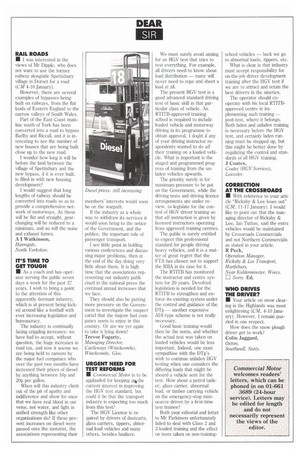DEAR SIR
Page 54

If you've noticed an error in this article please click here to report it so we can fix it.
RAIL ROADS • I was interested in the views of Mr Dipple, who does not mmit to use the kgrner railway alongside Spettisbury village in Dorset for a road (CM 4-10 January).
However, there are several examples of bypasses being built on railways, from the flat lands of Eastern England to the narrow valleys of South Wales.
Part of the East Coast mainline south of York has been converted into a road to bypass Barlby and RiccaIt, and it is interesting to see the number of new houses that are being built close up to the new road.
1 wonder how long it will be before the land between the village of Spettisbury and the new bypass, if it is ever built, is filled in with new housing development?
I would suggest that long lengths of railway should be converted into roads so as to provide a comprehensive network of motorways. As these will be flat and straight, gearchanging will be reduced to a minimum, and so will the noise and exhaust fumes.
A I Watkinson, Harrogate, North Yorkshire.
• As a coach and bus operator serving the public seven days a week for the past 27 years, I wish to bring a point to the attention of this apparently dormant industry, which is at present being kicked around like a football with ever increasing legislation and bureaucracy.
The industry is continually facing crippling increases: we have had to accept, without question, the huge increases in road tax, and now it seems we are being held to ransom by the major fuel companies who over the past two months have increased their prices of diesel by anything between 16p and 20p per gallon.
When will this industry climb out of the pit of apathy and indifference and show for once that we have real blood in our veins, not water, and tight in unified strength like other organisations do? If these present increases on diesel were passed onto the motorist, the associations representing their members' interests would soon be on the warpath.
If the industry as a whole was to withdraw its services it would soon bring to the notice of the Government, and the publice, the important role of passenger transport.
I see little point in holding various conferences and discussing major problems, then at the end of the day doing very little about them. It is high time that the associations representing our industry publicised in the national press the continual annual increases that we face.
They should also be putting more pressure on the Government to investigate the suspect cartel that the majore fuel cornpanes seem to enjoy in this country. Or are we yet again to take it lying down?
Trevor Fogarty, Managing Director, Castleways (Winchcombe), Winchcombe, Glos.
URGENT NEED FOR TEST REFORMS • Commercial Motor is to be applauded for keeping mil the current interest in improving the LIGV test standard, but could it be that the transport industry is expecting too much from this test?
The HGV Licence is required by drivers of dustcarts, glass carriers, tippers, abnormal load vehicles and many others, besides hauliers. We must surely avoid aiming for an HGV test that tries to test everything. For example, all drivers need to know about load distribution — many will never need to rope and sheet a load at all.
The present HGV test is a good advanced standard driving test of basic skill in that particular class of vehicle. An RTITB-approved training school is required to include loaded vehicle and motorway driving in its programme to obtain approval. I doubt if any of your driving instructor respondents wanted to do all their training on a loaded vehicle. What is important is the staged and programmed progress of training from the unladen vehicles upwards.
The priority surely is for maximum pressure to be put on the Government, while the driving tests and driving licence arrangements are under review, to legislate for the control of HGV driver training so that all instruction is given by licensed instructors operating from approved training centres.
The public is surely entitled to expect this professional standard for people driving heavy vehicles, and it is a matter of great regret that the ETA has chosen not to support the RHA in its case for it.
The RT1TB has monitored the instructor and centre system for 20 years. Devolved legislation is needed for the R'Is1T13 to strengthen and enforce its existing system under the control and guidance of the
DTp another expensive ADI-type scheme is not really necessary.
Good basic training would then be the norm, and whether the actual test was taken on loaded vehicles would be less important. Indeed, one must sympathise with the DTp's wish to continue unladen HGV testing when one considers the differing loads that might be aboard a vehicle sent for the test. How about a petrol tanker, glass carrier, abnormal load, or timber carrying vehicle on the emergency-stop manoeuvre driven by a first-time test trainee?
Both your editorial and letter to Mr Parkinson unfortunately failed to deal with Class 2 and 3 loaded training and the effect on tests taken on non-training
school vehicles — back we go to abnormal loads, tippers, etc.
What is clear is that industry must accept responsibility for on-the-job driver development training after the HGV test if we are to attract and retain the best drivers in the nineties.
The operator should cooperate with his local RTITBapproved centre in implementing such training — post-test, where it belongs. Both laden and unladen training is necessary before the HGV test, and certainly laden running must be stepped up, but this might be better done by regulating the control and standards of all HGV training. J Coates, Coates (HGV Services), Leicester.
































































































